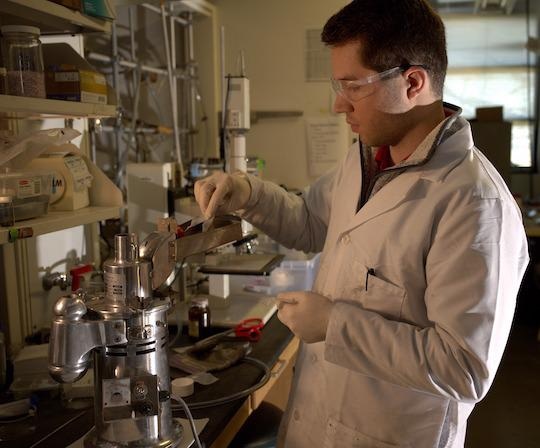Reviewed by Alex SmithApr 6 2022
There is another way to utilize the mountain of plastic that is waiting to be thrown away: use it to soak up surplus carbon dioxide.
 Graduate student Paul Savas feeds raw plastic into a crusher to prepare it for pyrolysis, or heating in an inert atmosphere. Image Credit: Jeff Fitlow.
Graduate student Paul Savas feeds raw plastic into a crusher to prepare it for pyrolysis, or heating in an inert atmosphere. Image Credit: Jeff Fitlow.
Rice University's newly found chemical method to convert waste plastic into an efficient carbon dioxide (CO2) sorbent for the industry looks like a win-win for a couple of pressing environmental issues.
Rice chemist James Tour and co-lead authors Rice alumnus Wala Algozeeb, graduate student Paul Savas and postdoctoral researcher Zhe Yuan published in the American Chemical Society journal ACS Nano that heating plastic waste in the existence of potassium acetate produced particles with nanometer-scale pores that catch carbon dioxide molecules.
The researchers reported that the particles could be utilized to eliminate CO2 from flue gas streams.
Point sources of CO2 emissions like power plant exhaust stacks can be fitted with this waste-plastic-derived material to remove enormous amounts of CO2 that would normally fill the atmosphere. It is a great way to have one problem, plastic waste, address another problem, CO2 emissions.
James Tour, Chemist, Rice University
A process utilized at present to pyrolyze plastic called chemical recycling produces gases, waxes and oils. However, the carbon byproduct is almost useless, stated Tour. But pyrolyzing plastic in the existence of potassium acetate generates porous particles able to hold up to 18% of their weight in CO2 at room temperature.
While normal chemical recycling does not function for polymer waste consisting of low fixed carbon content to produce CO2 sorbent, such as polypropylene and high- and low-density polyethylene, the primary constituents in municipal waste, those plastics function especially well for catching CO2 while being treated with potassium acetate.
The laboratory evaluates the cost of carbon dioxide capture from a point source like post-combustion flue gas which would be $21 a ton, far less affordable compared to the energy-intensive, amine-based process in common use to draw carbon dioxide from natural gas feeds, charging around $80 to $160 a ton.
Similar to amine-based materials, the sorbent could be reused. Heating it to around 75 °C (167 °F) liberates trapped carbon dioxide obtained from the pores, thereby regenerating nearly 90% of the binding sites of the material.
Since it cycles at 75 °C, polyvinyl chloride vessels are adequate to replace the costly metal vessels that are generally needed. The scientists observed that the sorbent has been anticipated to have a prolonged lifetime compared to liquid amines. This cuts downtime as a result of sludge formation and corrosion.
To create the material, waste plastic is converted into powder, mixed with potassium acetate and heated at 600 °C (1,112 °F) for around 45 minutes to improve the pores, the majority of which measure around a width of 0.7 nm. Higher temperatures resulted in wider pores. Also, the researchers stated that the process produces a wax byproduct that could be recycled into detergents or lubricants.
Co-authors of the paper are Rice alumnus Zhe Wang and research scientist Carter Kittrell, and graduate student Jacklyn Hall and Praveen Bollini, an assistant professor of chemical and biomolecular engineering, both of the University of Houston. Tour is the T.T. and W.F. Chao Chair in Chemistry as well as a professor of materials science and nanoengineering.
This study was financially supported by the Department of Energy (DE-F0031794) and Saudi Aramco.
Journal Reference:
Algozeeb, W. A., et al. (2022) Plastic Waste Product Captures Carbon Dioxide in Nanometer Pores. ACS Nano. doi.org/10.1021/acsnano.2c00955.